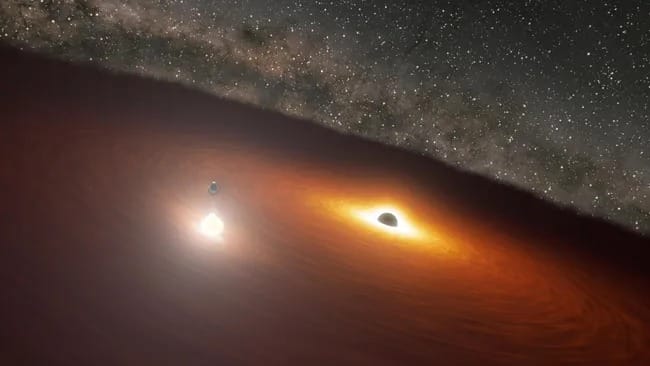The James Webb Space Telescope has revealed enormous black holes in the universe’s infancy, far too massive for their age. New research points to primordial “seeds”—dense matter from the Big Bang—as the key to their rapid formation, offering fresh insights into cosmic evolution
Headlines
James Webb Telescope Uncovers ‘Impossible’ Black Holes: A New Cosmic Mystery Explained

Astronomers have long been baffled by the existence of supermassive blackholes that appear fully formed in the universe’s earliest eras. A new study now proposes that these cosmic giants may have originated as tiny, primordial “seeds” at the dawn of the Big Bang.
Nearly all galaxies harbor supermassive holes at their cores, ranging from 100,000 to billions of times the mass of the sun. Recent observations from the James Webb Space Telescope (JWST) have revealed that some of these immense holes existed just a few hundred million years after the Big Bang, during the universe’s earliest stages of star and galaxy formation.
The puzzle lies in their rapid growth. Blackholes typically form from the deaths of massive stars, which then merge and accumulate material over time. However, these early supermassive blackholes would have needed to complete this entire process at an extraordinary speed, defying conventional understanding.
This puzzling phenomenon has driven scientists to explore innovative ideas for the rapid formation of massive black holes. A paper submitted to the Journal of Cosmology and Astroparticle Physics offers a bold hypothesis: these colossal black holes may have originated in the universe’s earliest moments.
In the 1970s, Stephen Hawking proposed that countless tiny black holes might have formed during the first fractions of a second after the Big Bang. Unlike typical holes formed from collapsing stars, these so-called primordial blackholes would arise directly from the extreme compression of matter and energy during the chaotic fluctuations of the early universe.
Hawking theorized that these black holes, potentially as small as asteroids, would gradually decay through a process known as Hawking radiation and could still be detectable today. However, decades of observational surveys have found no definitive evidence of their existence, suggesting that if primordial holes are real, they account for only a minuscule fraction of the universe’s matter.
This small population of primordial black holes could be transformative. Researchers found that even a tiny fraction of these early black holes, if situated in dense regions of matter, could rapidly accrete material and grow to supermassive proportions within 100 million years. This timeline aligns with the epochs when JWST observed these massive black holes.
In this model, supermassive black holes—potentially including the one at the center of the Milky Way—would not emerge after the firsts stars and galaxies formed. Instead, they would grow in tandem with them, gaining most of their mass during the cosmic dark ages, long before starlight illuminated the universe. By the time the first stars ignited, these massive black holes would already be towering cosmic behemoths, coexisting with the earliest celestial structures.
For now, this remains a hypothesis. Researchers suggest incorporating this primordial black hole growth model into simulations of early star and galaxy formation. By comparing the outcomes to real observations, scientists may finally determine if this bold idea can unravel the mystery of the universe’s earliest supermassive black holes.
At this stage, the idea is only a hypothesis. The researchers propose that this model of black hole growth should be incorporated into simulations of the development of the first stars and galaxies to see how realistic the scenario is. Then, they can compare those more realistic black holes to observations and see if this explains the mystery






